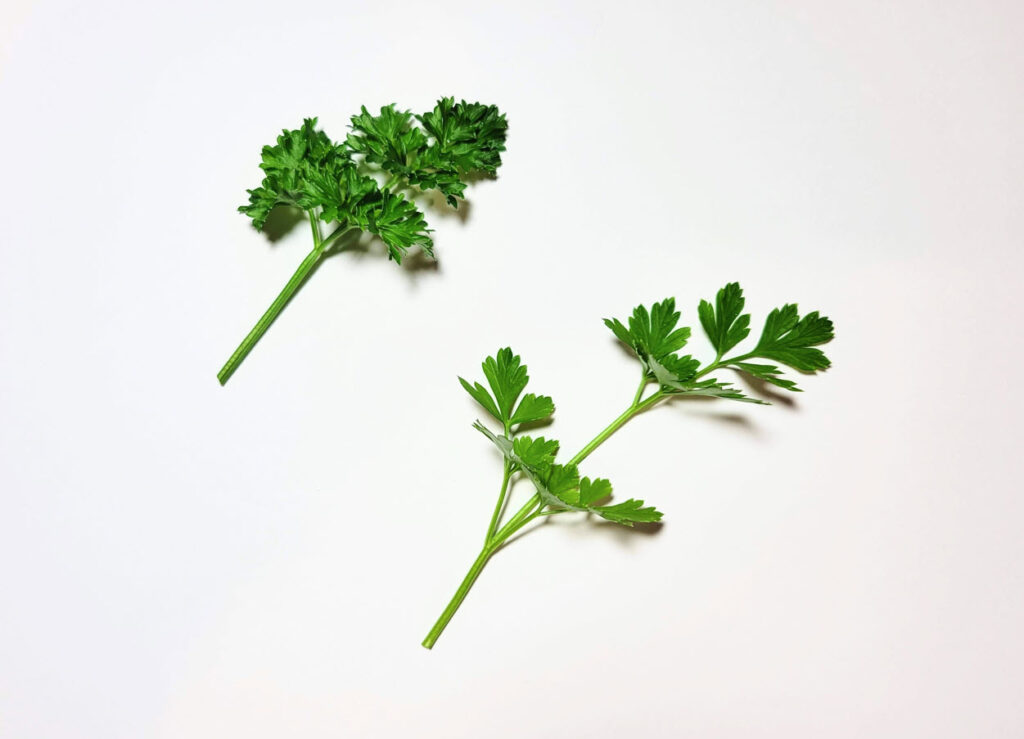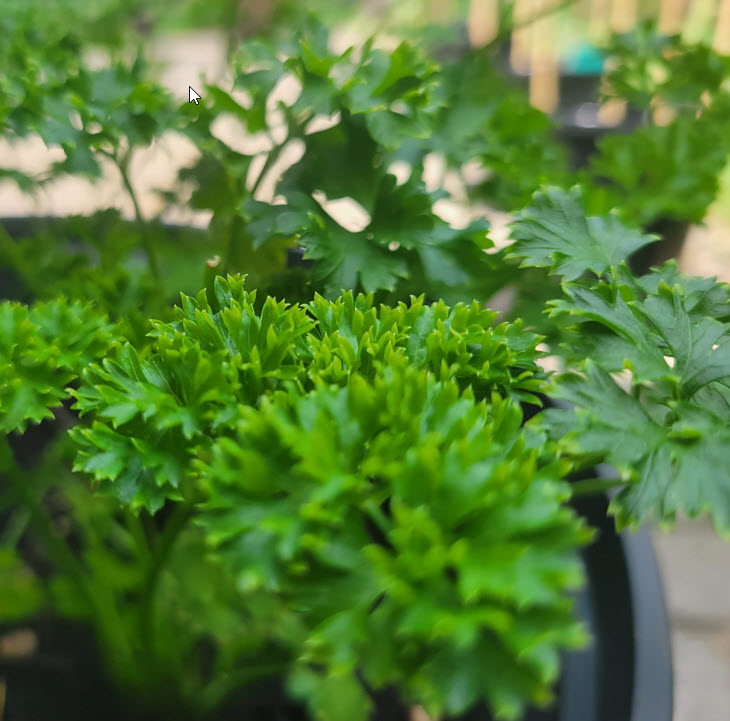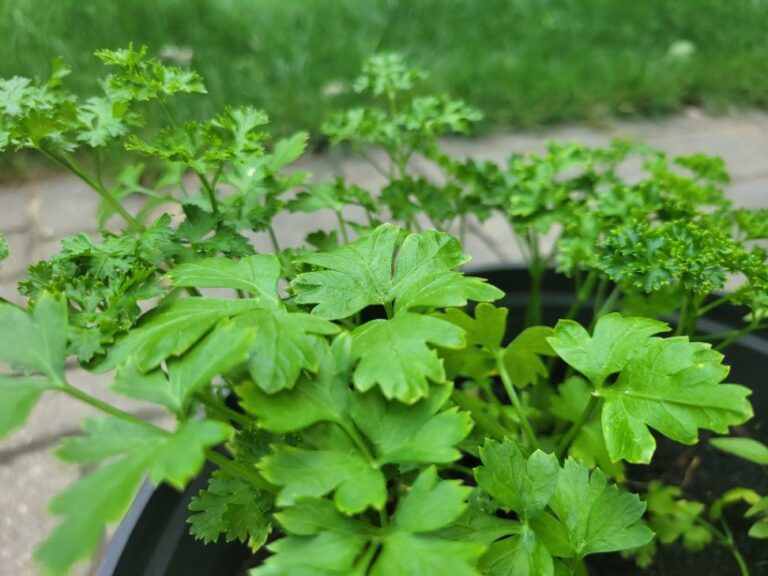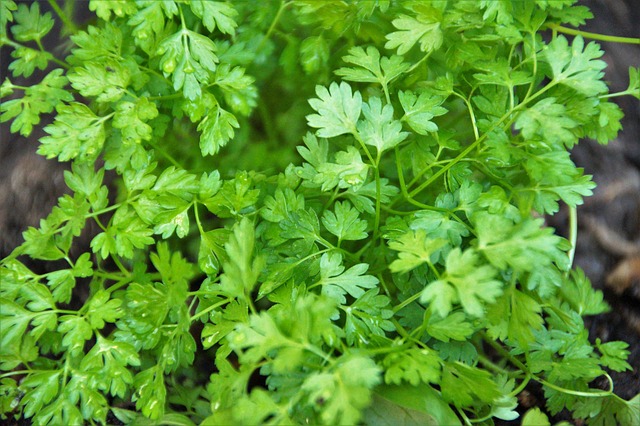This post may contain affiliate links which means I may receive a commission for purchases made through links. I only recommend products that I have personally used. As an Amazon Associate I earn from qualifying purchases. Learn more on my Private Policy page.

Parsley is a humble yet powerful herb that has the ability to transform any dish. There are a number of different types of parsley to grow and to cook with, each with its own distinct characteristics.
What are the different types of parsley? The two most common types of parsley are curly parsley and Italian parsley. Curly parsley has tightly curled leaves and a mild flavor, while Italian parsley, also known as flat-leaf parsley, has a strong flavor and sturdy texture.
There are also lesser-known types of parsley like Japanese parsley, Hamburg root parsley, and chervil. Each of these types has its own unique flavor and texture, adding more options to your cooking.
Table of Contents
See my Comprehensive Guide to Parsley for an in-depth look into this aromatic herb.
Curly-Leaf vs. Flat-Leaf Parsley: What’s the Difference?
Curly leaf and flat-leaf parsley both belong to the same parsley family (Apiaceae), but they have distinct differences.

- Curly leaf parsley has a milder taste and is commonly used as a decorative garnish. Its attractive appearance and delicate curls add freshness and visual appeal to salads, soups, and main courses.
- Flat-leaf parsley features a robust flavor, making it suitable for high-heat cooking and savory dishes. Its sturdy texture and vibrant green color also make it ideal for finely chopping or garnishing.
Overall, flat-leaf parsley stands out for its bold flavor, while curly leaf parsley excels as a delicate and visually appealing accent.
There are several other varieties of parsley beyond the most commonly used types. Let’s further explore the various types of parsley that can be used for culinary purposes.
Curly Parsley

Curly parsley (Petroselinum crispum var. crispum) is an herb that adds both flavor and visual appeal to dishes. Curly parsley has a compact and bushy growth habit, featuring dark green leaves that are tightly curled. These leaves are ideal for garnishing purposes.
Curly Parsley Growing Conditions
Curly parsley thrives best in cooler climates with moist, well-drained soil. Curly parsley is extremely cold tolerant and can be grown in zones 2-11. It prefers full sun but also appreciates some afternoon shade in hot climates to prevent the leaves from wilting or scorching.
Flavor Profile of Curly Parsley
One notable characteristic of curly parsley is its milder flavor compared to other parsley varieties. Its taste is more subtle and less pungent, making it an excellent choice for those who prefer a gentler note in their dishes.
Curly parsley is not only flavorful but can also add texture and visual appeal as a garnish. The tightly curled leaves create an attractive decorative element that elevates the presentation of any dish. Whether you’re preparing soups, stews, sauces, or salads, adding a sprinkle of curly parsley on top can instantly enhance both the aesthetics and taste.
Curly Parsley Culinary Uses
Curly parsley finds its way into various recipes around the world. Here are some common ways to incorporate this versatile herb into your cooking:
- Soups: Add chopped curly parsley towards the end of cooking to infuse your soups with freshness.
- Stews: Use finely minced curly parsley as a finishing touch to brighten up hearty stews.
- Sauces: Mix chopped curly parsley into homemade sauces like pesto or chimichurri for added depth of flavor.
- Salads: Toss a handful of fresh curly parsley leaves into green salads for extra vibrancy.
The versatility of curly parsley extends beyond these examples. I encourage you to experiment and explore its potential in your favorite recipes.
Italian Parsley

Italian parsley (Petroselinum crispum var. neapolitanum), also known as flat-leaf parsley, is a popular herb with numerous culinary uses. Italian parsley is characterized by its bush-like growth, reaching up to 24” (60 cm) tall. Italian parsley features vibrant green leaves that are flat, smooth, and serrated.
Growing Conditions of Italian Parsley
This variety of parsley thrives best in cooler climates with moist and well-drained soil. Italian parsley exhibits remarkable cold tolerance, making it suitable for zones 2 to 11. While it prefers full sun to part shade, it’s important not to overcrowd the plants as they require proper airflow. Italian parsley can withstand higher growing temperatures compared to other types of parsleys.
Once established, Italian parsley plants require regular watering to maintain moisture levels in the soil. It’s advisable to water deeply rather than frequently since this encourages deeper root growth and helps plants withstand dry periods more effectively.
Italian parsley can also be grown in containers, providing you with the flexibility to move them around and position them in the ideal spot for optimal growth. Just make sure the containers have proper drainage to prevent waterlogging.
Italian Parsley Flavor Profile
Italian parsley brings a robust and fresh flavor profile to dishes, characterized by a vibrant combination of earthiness, hints of citrus, and a subtle peppery undertone. Its robust flavor pairs exceptionally well with Mediterranean cuisine, enhancing the overall taste profile of various recipes.
Culinary Uses of Italian Parsley
A staple in Italian cuisine, Italian parsley is commonly used as a key ingredient in pasta sauces, risottos, and soups, adding a fresh and vibrant taste to these dishes. It is also an essential component of traditional Italian herb blends, such as gremolata and pesto. Moreover, Italian parsley’s versatility extends beyond Italian dishes, as it can be used to enhance the flavors of salads, marinades, and grilled meats. Whether it’s used as a garnish or a flavor enhancer, Italian parsley can bring a delightful depth of flavor to your cooking dishes.
Japanese Parsley
Japanese parsley (Cryptotaenia japonica), also known as Mitsuba or Japanese wild parsley, is a unique herb that adds a distinctive flavor to various dishes. Despite its name, it is not technically a species of parsley, although it is a member of the Apiaceae family to which parsley belongs. Japanese parsley features long stems with dark green glossy leaves that are serrated in appearance.
Japanese Parsley Growing Conditions
Japanese parsley prefers partial shade along with moist, well-drained soil that is rich in organic matter. Adequate watering is essential to keep the soil consistently moist, but it is important to avoid overwatering, as excessive moisture can lead to root rot. Japanese parsley can withstand colder temperatures and is hardy in zones 4-7, making it an excellent addition to gardens in these regions.
Flavor Profile of Japanese Parsley
Japanese parsley offers a mild yet somewhat bitter flavor profile. It is often described as a combination of parsley, celery, and cilantro. This unique blend of flavors makes it a versatile ingredient in various culinary creations.
Japanese Parsley Culinary Applications
The uses of Japanese parsley differ depending on the part of the plant being utilized. The leaves are commonly used as a seasoning in numerous dishes such as soups and stews. Their vibrant taste enhances the overall flavor profile of these recipes, adding depth and complexity.
The roots of Japanese parsley can be eaten as a vegetable. They possess a distinct earthy flavor that pairs well with other ingredients in stir-fries or roasted dishes.
In addition to leaves and roots, sprouts from Japanese parsley can be tossed into salads for an extra burst of freshness and crunchiness. These sprouts add visual appeal to your salad bowl while infusing it with their unique flavor.
Japanese parsley culinary uses can be summarized as follows:
- Leaves: Used as seasonings in soups and stews.
- Roots: Eaten as a vegetable; ideal for stir-fries or roasted dishes.
- Sprouts: Tossed into salads for added freshness and crunchiness.
Japanese parsley’s distinct taste and versatility make it a valuable ingredient in various cuisines. Whether you’re looking to enhance the flavor of your soups, experiment with vegetable dishes, or add vibrancy to your salads, Japanese parsley is an excellent option to consider.
Hamburg Root Parsley
Hamburg root parsley (Petroselinum crispum var. tuberosum), also known as Hamburg parsley, root parsley or turnip-rooted parsley, is a unique variety of parsley that is prized for its thick, parsnip-like root. While the leaves can still be used as seasoning or garnish like other parsley varieties, it is primarily grown for its flavorful and versatile tuber.
Growing Conditions of Hamburg Parsley
Hamburg parsley thrives in full sun to partial shade and prefers well-drained soil that is loose, deep, and rich in organic matter. It is important to provide consistent moisture to the plant, ensuring that the soil remains evenly moist but not waterlogged. Hamburg root parsley is a cool-season crop and can tolerate mild frosts. Cold hard to zones 5-10, Hamburg root parsley it suitable for regions with cooler climates. Regular watering and occasional fertilization can promote healthy growth and encourage the development of its flavorful roots.
Hamburg Parsley Flavor Profile
The tubers of Hamburg parsley possess a unique and delightful flavor that combines the nuttiness of celery with the sweetness of carrots. This distinct taste makes it a popular addition to various culinary dishes. When cooked, the root softens and develops a tender, yet slightly crunchy texture that adds depth to dishes.
Culinary Uses of Hamburg Root Parsley
Hamburg parsley offers an array of culinary possibilities due to its flavorful root. Here are some exciting ways you can incorporate this versatile ingredient into your cooking:
- Soups and Stews: Add diced or sliced hamburg parsley root to soups and stews for a delicious twist. Its earthy flavor complements well with other ingredients, infusing the dish with rich taste.
- Roasted Vegetables: Toss chunks of Hamburg parsley root and other root vegetables with olive oil, salt, and pepper, then roast them in the oven until they turn golden brown. The caramelization enhances their natural sweetness while maintaining their delightful crunch.
- Mashed Potatoes: Mix boiled or roasted hamburg parsley root with mashed potatoes for a unique twist on this classic side dish. It adds extra depth and complexity to the creamy texture.
- Salads: Shred raw Hamburg parsley root into salads similarly as you would with carrots for an unexpected burst of flavor and added crunch. It pairs particularly well with citrus-based dressings or vinaigrettes.
Chervil (French Parsley)
Chervil (Anthriscus cerefolium), also known as French parsley, is characterized by its bright green feathery and delicate leaves that grow to a height of 12-24” (30-60 cm). With a bushy habit, chervil spreads outwards as it grows, creating an attractive addition to any garden.
Chervil Growing Conditions
While not technically a member of the parsley family, chervil prefers partial to full shade and cooler conditions. To ensure healthy growth, provide well-draining moist soil for this herb. Chervil is not nearly as cold tolerant as true parsley varieties, and is only cold hardy in zones 6-9. Chervil can be cultivated both indoors and outdoors, making it a versatile choice for herb enthusiasts.
Flavor Profile of Chervil
One of the most distinctive aspects of chervil is its flavor profile. It possesses a delicate taste reminiscent of anise that beautifully complements fish and poultry dishes. The subtle notes of chervil add depth and complexity to these meals without overpowering their natural flavors.
Chervil Culinary Uses
In French cuisine, chervil holds a prominent place due to its unique taste and versatility in pairing with various ingredients. This type of parsley enhances the flavors of fish, poultry, and vegetables alike. Chefs often use chervil to infuse soups, salads, sauces, and egg dishes with its delightful aroma and taste.
Some common culinary uses of chervil include:
- Soups: Add chopped fresh chervil towards the end of cooking soups such as potato leek or tomato bisque for an aromatic touch.
- Salads: Sprinkle freshly chopped chervil over mixed greens or incorporate it into salad dressings for a burst of freshness.
- Sauces: Mix minced chervil into creamy sauces like Hollandaise or Béarnaise to elevate the overall flavor.
- Egg dishes: Whisk chopped chervil into scrambled eggs or use it as a garnish for omelets, frittatas, or quiches.
The delicate nature of chervil makes it particularly suitable for enhancing the flavors of light and delicate dishes. Its feathery leaves not only add visual appeal but also contribute a subtle yet distinctive taste that sets these meals apart.
Conclusion
Understanding the unique characteristics of different parsley types can significantly enhance our culinary experiences. Whether you’re using parsley as a garnish, flavor enhancer, or key ingredient, it’s clear that the different parsley varieties have their own culinary niches. From the robust flavor of Italian parsley in Mediterranean dishes, the visually appealing garnish of curly parsley, to the unique tastes and applications of Japanese parsley, Hamburg root parsley, and Chervil, the world of parsley is incredibly diverse. So, the next time you cook, remember there’s more than just one type of parsley to spice up your dishes. Each variety can bring a new dimension of flavor and aesthetics, making every meal a delightful and unique experience. Happy cooking!
Frequently Asked Questions (FAQs)
What is the best type of parsley for cooking?
Italian parsley, also known as flat-leaf parsley, is widely considered the best type of parsley for cooking due to its robust flavor and versatility in various dishes. It is also better at keeping its flavor and texture when cooked at high temperatures.
Can I use any type of parsley interchangeably in recipes?
Each type of parsley has its own distinct flavor profile and characteristics. While they can be used interchangeably in some cases, it’s best to follow recipes that specify which type is recommended for optimal results.
Are all types of parsley easy to grow?
Parsley is generally easy to grow and can thrive in both garden beds and containers. However, some varieties have specific growing requirements, so it’s essential to research the specific needs of the type of parsley you wish to cultivate.
What other herbs grow well with parsley?
Basil and chives are both excellent parsley companion plants due to their similar growing requirements. These herbs all have similar soil, water and sunlight preferences.
Can I freeze parsley for later use?
You can freeze parsley to preserve its freshness. Simply wash and dry the leaves thoroughly, chop them finely, and place them in an airtight container or freezer bag. Frozen parsley works well in cooked dishes but may lose some texture when used fresh.
Check out our harvesting and preserving parsley guide for more tips and techniques to extend your parsley harvest.
How long does parsley typically last before it goes bad?
Fresh parsley can last up to two weeks when stored properly. To extend its shelf life, trim the stems and place the bunch in a glass of water like a bouquet. Cover it loosely with a plastic bag and store it in the refrigerator.
Can I use dried parsley instead of fresh?
While dried parsley can be used as a substitute in recipes that call for fresh parsley, keep in mind that the flavor will not be as vibrant. Dried parsley works best in cooked dishes where its flavor has time to infuse into the dish.
Can I use leftover stalks from curly-leaf or Italian parsley?
While the leaves are typically preferred for culinary purposes due to their milder taste and better texture, you can still use leftover stalks from curly-leaf or Italian parsley by adding them to stocks or soups for added flavor.
Are there any other herbs that pair well with different types of parsley?
Parsley combines nicely with various herbs like basil, mint, cilantro, and dill when used in cooking. Experimenting with different herb combinations can create exciting flavor profiles in your dishes.
Last Updated on 25 October 2023 by Bob Lee


